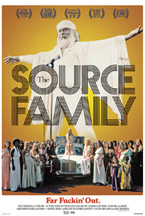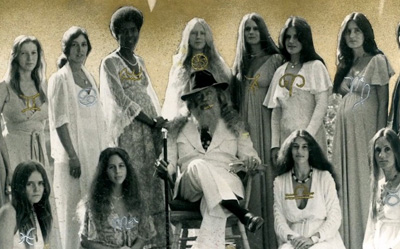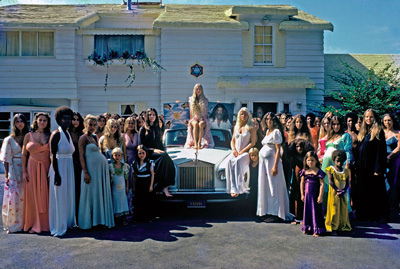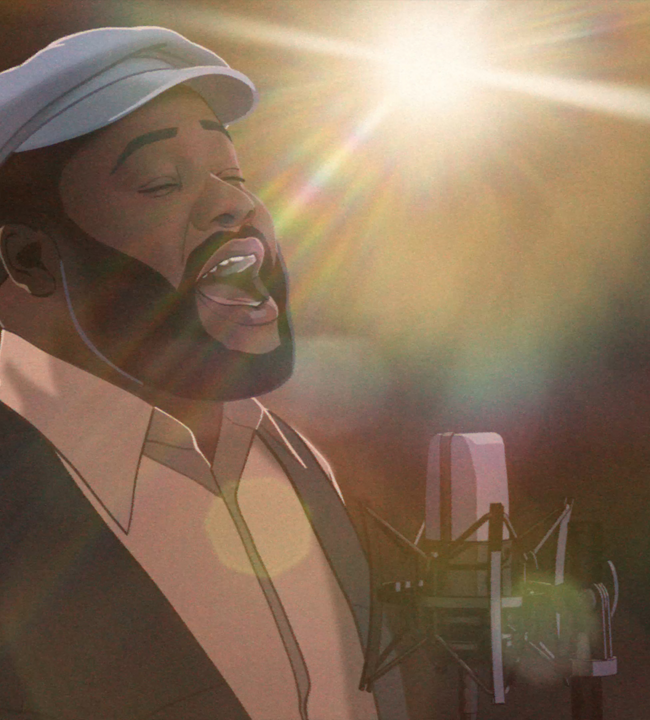
(The Source Family is now available on DVD and at Amazon Instant. It world premiered at the 2012 SXSW Film Festival and opened theatrically via Drag City Film Distribution on Wednesday, May 1, 2013. Visit the film’s official website for screening details—it will be screening in many cities throughout May—and more general information about the film.)
In 1870 John Humphrey Noyes, head of the Oneida Community, published a book that detailed the history of alternative communities. History of American socialisms was later renamed Strange Cults & Utopias of 19th Century America and was actually an update on an earlier book that detailed a few of these societies as far back as 1844. Even by 1870, there was a long history of alternative utopian groups, or, as they were later called, cults. These groups, including the longstanding Mormons, are as American as apple pie; in some ways, they are an essential part of the American identity. They continued to flourish after the 19th century (Krishna Venta in California, Franz Edmund Creffield in Oregon, etc.). All were popular post-war groups that continued what Noyes described in respect to Owenism and Fourierism: “the enlargement of home—the extension of the family union beyond the little man and wife circle into larger corporations.”
 In the mid-1980s, I came upon a strange LP in a Eugene Oregon thrift shop. While I was staring at the cover that featured a white-bearded, long-haired older man surrounded by pretty young longhairs in white robes, the clerk came up behind me. “That’s some heavy shit my brother,” he whispered in my ear. He got my attention and then he launched into what he knew about the ’70s-era group called Source Family headed by the mystic Father Yod. He compared them to another group that at the time had taken over a town in Oregon. The head of the Rajhneesh, like Father Yod, drove a white Rolls Royce and engaged in some form of free sex with lots of young pretty hippies. Like the Source Family, it didn’t end well for the Rajhneesh: they started poisoning the local salad bars as a way of dealing with the Oregon locals trying to throw them out of town. The story of the Source Family is in many ways very similar to the countless amounts of alternative societies in America, but this one is unique because there was a filmmaker/photographer anointed by Father Yod as the family’s official chronicler: Isis Aquarian. Consequently, there is an amazing amount of first-hand footage from the period.
In the mid-1980s, I came upon a strange LP in a Eugene Oregon thrift shop. While I was staring at the cover that featured a white-bearded, long-haired older man surrounded by pretty young longhairs in white robes, the clerk came up behind me. “That’s some heavy shit my brother,” he whispered in my ear. He got my attention and then he launched into what he knew about the ’70s-era group called Source Family headed by the mystic Father Yod. He compared them to another group that at the time had taken over a town in Oregon. The head of the Rajhneesh, like Father Yod, drove a white Rolls Royce and engaged in some form of free sex with lots of young pretty hippies. Like the Source Family, it didn’t end well for the Rajhneesh: they started poisoning the local salad bars as a way of dealing with the Oregon locals trying to throw them out of town. The story of the Source Family is in many ways very similar to the countless amounts of alternative societies in America, but this one is unique because there was a filmmaker/photographer anointed by Father Yod as the family’s official chronicler: Isis Aquarian. Consequently, there is an amazing amount of first-hand footage from the period.
Jodi Wille and Maria Demopolous’s The Source Family starts off going into the past details of Father Yod before he became a longhair running the first health food restaurant in LA. The Source restaurant was one of the most popular spots in LA through the ’60s and into the early ’70s. We are led to assume that it was the restaurants profits that supported the Source Family’s alternative lifestyle, but those specific infrastructure details unfortunately are not fully explained here. There are several former family members who serve as narrators, describing what it was like during the various stages of the family’s decade-long evolution. These interviews alternate with the mostly silent super-8 footage and photos, set to a soundtrack made up of the Source Family band jams. As a longtime fan of such groups, I am always fascinated by the small details regarding the physical management of their alternative lifestyles. Ultimately, the most successful and longest running groups—Mormons, Oneida, and Church of Scientology—were, above all, successfully run financial corporations. Though these financial details are lacking in the film’s interviews, the visuals and soundtrack more than compensate for that omission and ultimately produce a captivating glimpse inside an fascinating alternate world.
 As in all family stories, there is rebellion, pain and disappointment. Father Yod’s first Family wife, who bore him a son, eventually has her heart broken when Father Yod decides to expand the family’s activities into free group sex. She serves as our primary source of information regarding the more negative aspects of group life; the particular issues connected to a sexually driven family headed by one man are touched upon, but again are not fully explored.
As in all family stories, there is rebellion, pain and disappointment. Father Yod’s first Family wife, who bore him a son, eventually has her heart broken when Father Yod decides to expand the family’s activities into free group sex. She serves as our primary source of information regarding the more negative aspects of group life; the particular issues connected to a sexually driven family headed by one man are touched upon, but again are not fully explored.
Unlike some other more recent cults that ended violently, like at Spahn Ranch, Waco, or Guyana, Father Yod took himself out when his experiment in group living had run its course in Hawaii. His demise is as dramatic and colorful as those intense acid electric jams contained on many Source Family records (I think it didn’t end violently in part because they were living in mellow Hawaii and the authorities were probably more concerned with the surf tides compared to the pumped up Texans in Waco). But as their final days unfold, you can sense that at some point it really could have ended darker than it did. The Source Family is a fantastic insider’s look into a common American phenomenon: the free love alternative utopian society. What is perhaps most remarkable is that the Source Family lasted as long as it did and that the ex-members still seem to be as supportive of Father Yod’s vision now as they were when he was still alive.
— Mike S. Ryan












Pingback: HOME VIDEO PICKS – Hammer to Nail